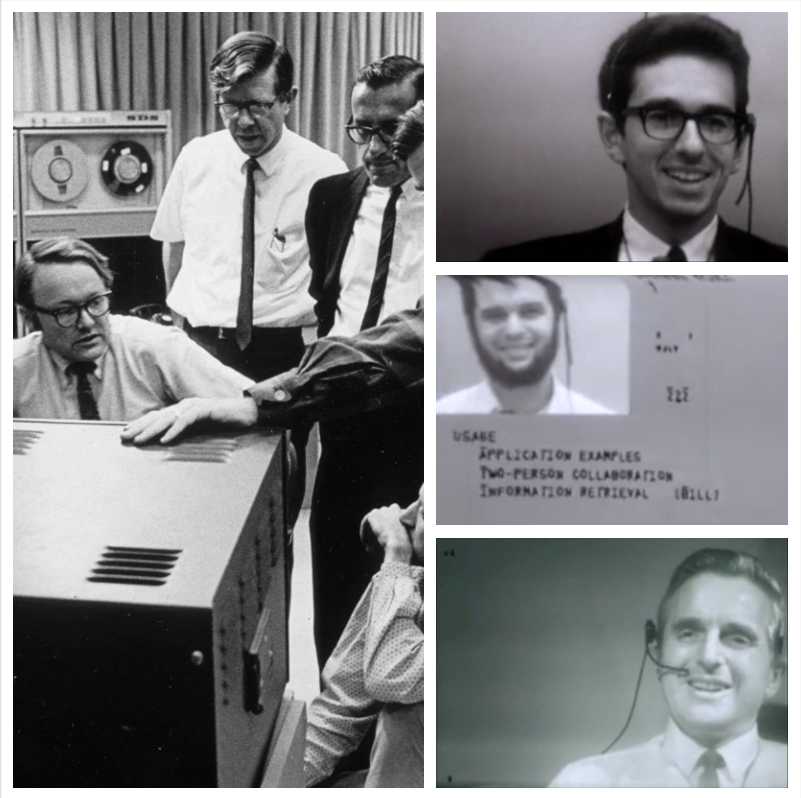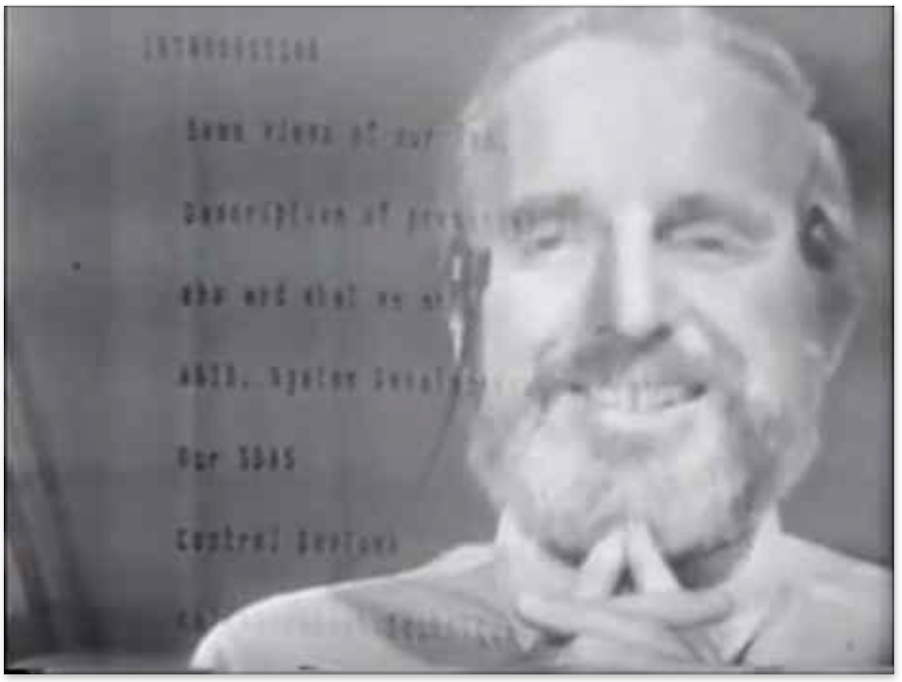Outline offers a bird's eye view; Numbers and Labels show hotlinks you can click to Jump to, or right click to Copy Link to; Numbers show where you are. Learn more.
AUDIENCE REACTION 2b
The audience of ~2,000 conference-goers erupted into a standing ovation. Watch these comments by three attendees sharing decades later:
"To me he was Moses opening the Red Sea" More insights from Alan Kay below AND MORE 2c
Memorabilia: See the Session Poster announcing Doug's presentation, his go-to archive photos at his History in Pix, and our photo gallery of the Demo project on Facebook. Conference Proceedings: Read the paper by Doug and his team that accompanied their presentation: A Research Center for Augmenting Human Intellect, published in the Proceedings of the 1968 Fall Joint Computer Conference. Check out the conference proceedings Table of Contents to see who all was presenting what [browseable at ACM Library]. What were they thinking?: The story of the demo is as fascinating as the demo itself. Why did they do it, how did they do it, what was it like behind the scenes, who was in the audience, how was it received? Check out Reflecting on the Demo below to hear Doug and his team's reflections, and read Adam Fischer's How Doug Engelbart Pulled off the Mother of All Demos. See Colleagues, Press, and Presidents for more. Online Exhibits: Explore the MouseSite at Stanford for stories, archive video, photos, and key technical papers from the Douglas C. Engelbart Collection at Stanford Libraries Special Collections. See SRI's Timeline on Innovation: Computer Mouse and Interactive Computing for concise background and overall significance of the demo. Browse the virtual exhibits showcasing Doug's work at the Computer History Museum. NEW! Co-Designing the Console: Learn about Doug's collaboration with Herman-Miller Research, pioneers of the office of the future, who produced the custom swivel console with Eames chair and world's first mousepad used in the demo.
And More: See also the 1968 Demo Table of Contents which links to specific sections of the Demo, the Detailed Onscreen Outline, and a draft transcript of the Demo.
Part of a Larger Vision 3Most of what Doug and his team presented in 1968 was developed literally "from scratch" by a handful of researchers in the space of roughly 2 years. The system, called NLS, was used day in and day out by the research team for almost every aspect of their work – they were living and breathing the organization of the future and the future of work as an advanced pilot expedition, pushing the envelope of intelligence augmentation and collective IQ with transformative practices and paradigms alongside the rapidly evolving technology, using a special evolutionary bootstrap approach (watch Doug describe the approach during the demo). He reasoned that organizations would have to get alot more effective at tackling wicked problems, especially as we moved into a future of accelerated change and disruption at a scale never before experienced by business or society (yes, he predicted this in 1960 and adapted his strategic vision accordingly). The demo was essentially a snapshot in time on a continuum of cross-cutting breakthrough innovation in which they were rigorously prototyping the fast, fluid organization of the future, while co-evolving the technology in the service of that. See Historic Firsts for more, as well as the Engelbart Academy for his prescient call to action. 3a
❝
The demo was essentially a
Reflecting on the Demo 4Learn more about the making of the demo, the system being demonstrated, the team that made it happen, how and why it was conceived and evolved, its significance, and what it was like working in Doug's innovative lab at that point in time. 4a Doug and His Team 4b
The Augmented Knowledge Workshop Learn more at Doug's Historic Talk: Anniversary Events 4b2 Some fabulous anniversary events were later held to commemorate the demo, with panel discussions by Doug, members of his research team who participated in the 1968 demo, and invited guests discussing what it took to put on the demo that day, what it was like behind the scenes, and the significance of the work they were doing then and now.
30th Anniversary Event: Contemplating the event's title "The Unfinished Revolution," futurist Paul Saffo remarked: "because the extraordinary thing is, even with the events that were demonstrated 30 years ago, more remains unfinished than has been completed." Visit the 30th Anniversary event website for more
❝because the extraordinary thing is,
even with the events that were demonstrated
40th Anniversary Event: Watch the Stanford News Report on the Event (3 min. video) - an excellent compilation. Visit the 40th Anniversary event website for more.
50th Anniversary Event:
CONTENTS:
Introductions
|
Visit our 50th Anniversary Symposium website for more.
50th Anniversary Sister Event: CONTENTS: 1968 Demo - Key Takeaways | Today? | Focus on the Ideas, not the shiny objects | Systems Thinking to help us think | Big Idea: Systems Thinking essential for 'Augmenting Human Intellect'
The 50th Anniversary of
Oral Histories 4b3
White Rabbit Interview with Doug Engelbart and Bill English See our Archive showcase under Story of a True Pioneer for more.
Colleagues, Press, and Presidents 4c
Watch the other speakers and panelists reflecting on the 1968 Demo at the above events, luminaries such as Tim Berners-Lee, Vint Cerf, Ted Nelson, Alan Kay, Andy van Dam, Bob Taylor, Curt Carlson, Adam Cheyer, Howard Rheingold, John Markoff, Paul Saffo, Bob Sproull, Denise Caruso, Chuck House, and more [30th Anniv. Sessions | 40th Anniv Sessions | 50th Anniv. Sessions]. 4c1 See also this mid-1990s description of the demo by Brown University Center for Graphics and Visualization, Douglas Engelbart and 'The Mother of All Demos'. Andy van Dam, a principal investigator at the Center, attended the 1968 demo and was a guest speaker at all our Anniversary events. 4c3 PRESS: The big 50th anniversary events inspired some selected press about the demo, with more at our demo press archive. for a sampling. NEW! A Machine for Thinking: How Douglas Engelbart Predicted the Future of Computing, by Steven Johnson for Netguru's Hidden Heroes series. Watch the Stanford News report (3 min). See also top picks from 50th Anniv. Press, 40th Anniv. Press, and 30th Anniv. Press. Browse our Press Newsroom for a more comprehensive collection of articles dating back in time. 4c2
AWARDS: For his "most unusual contribution" to the success of the 1968 conference program, Doug Engelbart was awarded by the conference program organizers a hand carved tribute to his Demo, pictured at left. In recognition for achievements first showcased at the 1968 Demo, Doug Engelbart later received the National Medal of Technology and Innovation, the IEEE John Von Neumann Medal Award, the Benjamin Franklin Medal, the A.M. Turing Award, the Lemelson-MIT Prize, and the American Ingenuity Award. See Honors Awarded to Doug Engelbart for more on these and other awards. Inspired Artistic Creations 4d
'The Demo' now an avant garde opera at Stanford
See Also 5On the Web 5a
Key References 5b
More 5c
|
|||||||||||||||||||||||||||||||||||||||||||













